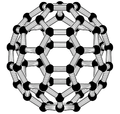
Fullerene chemistry

Fullerene chemistry is a field of organic chemistry devoted to the chemical properties of fullerenes. Research in this field is driven by the need to functionalize fullerenes and tune their properties. For example, fullerene is notoriously insoluble and adding a suitable group can enhance solubility. By adding a polymerizable group, a fullerene polymer can be obtained. Functionalized fullerenes are divided into two classes: exohedral fullerenes with substituents outside the cage and endohedral fullerenes with trapped molecules inside the cage. Fullerene chemistry is a field of organic chemistry devoted to the chemical properties of fullerenes. Research in this field is driven by the need to functionalize fullerenes and tune their properties. For example, fullerene is notoriously insoluble and adding a suitable group can enhance solubility. By adding a polymerizable group, a fullerene polymer can be obtained. Functionalized fullerenes are divided into two classes: exohedral fullerenes with substituents outside the cage and endohedral fullerenes with trapped molecules inside the cage. This article covers the chemistry of these so-called 'buckyballs,' while the chemistry of carbon nanotubes is covered in carbon nanotube chemistry. Fullerene or C60 is soccer-ball-shaped or Ih with 12 pentagons and 20 hexagons. According to Euler's theorem these 12 pentagons are required for closure of the carbon network consisting of n hexagons and C60 is the first stable fullerene because it is the smallest possible to obey this rule. In this structure none of the pentagons make contact with each other. Both C60 and its relative C70 obey this so-called isolated pentagon rule (IPR). The next homologue C84 has 24 IPR isomers of which several are isolated and another 51,568 non-IPR isomers. Non-IPR fullerenes have thus far only been isolated as endohedral fullerenes such as Tb3N@C84 with two fused pentagons at the apex of an egg-shaped cage. or as fullerenes with exohedral stabilization such as C50Cl10 and reportedly C60H8. Fullerenes with less than 60 carbons do not obey isolated pentagon rule (IPR). Because of the molecule's spherical shape the carbon atoms are highly pyramidalized, which has far-reaching consequences for reactivity. It is estimated that strain energy constitutes 80% of the heat of formation. The conjugated carbon atoms respond to deviation from planarity by orbital rehybridization of the sp² orbitals and π orbitals to a sp2.27 orbital with a gain in p-character. The p lobes extend further outside the surface than they do into the interior of the sphere and this is one of the reasons a fullerene is electronegative. The other reason is that the empty low-lying π* orbitals also have a high s character. The double bonds in fullerene are not all the same. Two groups can be identified: 30 so-called double bonds connect two hexagons and 60 bonds connect a hexagon and a pentagon. Of the two the bonds are shorter with more double-bond character and therefore a hexagon is often represented as a cyclohexatriene and a pentagon as a pentalene or radialene. In other words, although the carbon atoms in fullerene are all conjugated the superstructure is not a super aromatic compound. The X-ray diffraction bond length values are 139.1 pm for the bond and 145.5 pm for the bond. C60 fullerene has 60 π electrons but a closed shell configuration requires 72 electrons. The fullerene is able to acquire the missing electrons by reaction with potassium to form first the K6C6−60 salt and then the K12C12−60 In this compound the bond length alternation observed in the parent molecule has vanished. Fullerenes tend to react as electrophiles. An additional driving force is relief of strain when double bonds become saturated. Key in this type of reaction is the level of functionalization i.e. monoaddition or multiple additions and in case of multiple additions their topological relationships (new substituents huddled together or evenly spaced). In conformity with IUPAC rules, the terms methanofullerene are used to indicate the ring-closed (cyclopropane) fullerene derivatives, and fulleroid to ring-open (methanoannulene) structures. Fullerenes react as electrophiles with a host of nucleophiles in nucleophilic additions. The intermediary formed carbanion is captured by another electrophile. Examples of nucleophiles are Grignard reagents and organolithium reagents. For example, the reaction of C60 with methylmagnesium chloride stops quantitatively at the penta-adduct with the methyl groups centered around a cyclopentadienyl anion which is subsequently protonated. Another nucleophilic reaction is the Bingel reaction.Fullerene reacts with chlorobenzene and aluminium chloride in a Friedel-Crafts alkylation type reaction. In this hydroarylation the reaction product is the 1,2-addition adduct (Ar-CC-H). The bonds of fullerenes react as dienes or dienophiles in cycloadditions for instance Diels-Alder reactions. 4-membered rings can be obtained by cycloadditions for instance with benzyne. An example of a 1,3-dipolar cycloaddition to a 5-membered ring is the Prato reaction.
